December 29, 2014
At the Turn of the Centuries: Art and Politics in Sri
Lanka
Written by Sabine Grosser
Nearly half a century after the end of colonial rule a new generation of artists was developing in Sri Lanka during the 90s, who understood themselves in the context of a complex, changing and multifaceted culture rooted in a strong Buddhist tradition.
This generation not only redefined the concepts of the local art scene, developing new art forms, using art galleries and public space to distribute their ideas: they also used art as their main weapon to influence public opinion and contribute to a peaceful solution to the civil war and ongoing violence at the turn of the centuries.
Current social and political topics hardly played a major role in the pictures of Sri Lankan art until the end of colonialism. However, political tensions increased after Sri Lanka reached independence: The conflict escalated in 1983 into civil war. War and Violence dominated life on the island until the turn of the millennium, influencing the youth of a whole generation of artists in the 90s. Close to the turn of the millennium the local art- and exhibition-scene was dominated by this topic.
Chandraguptha Thenuwara and Jagath Weerasinghe were two artists of the new generation who confronted war and violence in their work. Both artists had returned in the early 90s from studies abroad. One came back from the Soviet Union and the other from the USA, to exhibit the results of their work in individual art shows. In these first exhibits in their homeland they were already reacting to news, which they had translated into art during their studies abroad.
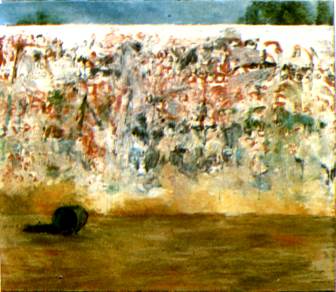
In 1992, Jagath Weerasinghe opened the exhibition Kaansaava - "Anxiety of Today“ in the National Gallery of Art in Colombo. The same year, Chandraguptha Thenuwara[1] presented a painting called "Mirror Wall“. In this painting he mediated his reaction to the news of the pogrom against the Tamils. In an interview[2] he described the artwork as his statement concerning the former political situation. The title "Mirror Wall“ refers to a rock face in Sigiriya by the same name, on which visitors have left their messages for centuries. Thenuwara interprets these graffiti as political statements which in his painting seem to have been covered with paint. The emptied bucket in the painting points to this imaginary action. According to the artist, the image of the emptied bucket generally represents the "Absence of something“. The “carelessly” spilled paint could also evoke associations to needlessly spilled blood.
Even though both exhibitions hinted relatively subtly to the topic by the choice of titles for the individual paintings, this is how the topics death, war and violence become introduced into the discourse of the Sri Lankan art-scene where mostly young artists took them up.
Expressive panel paintings were the dominating form of expression at the time. In Weerasinghe's and Thenuwara's artworks, helmets, body parts and crouches become symbols for the operators of war; the soldiers. Rather than being depicted as personified figures or as heroes or victors they were shown as victims. The composition of their paintings is fragmented, symbolizing wounded bodies, damaged by war.
Jagath Weerasinghe also worked with muted and broken colour palettes. The helmet, the body parts and the hand raised in premonition like a warning sign are clearly recognizable and stand in bright contrast to a diffuse background. The colour palette reminds the viewer of bush-fighting and blood. The dark green and red tones increase their effect through an intense complementary contrast. By the title: "Who are you Soldier“ the artist also speaks directly to the viewer: Who are you, son, father, husband – whose insignia of a soldier’s life is recognizable in the picture? As a whole, the artwork addresses the individual, to remind him of his individual societal responsibility.
Two years later Chandraguptha Thenuwara also questioned the role of the soldier with the title "Dance of Victory“: What remains after an alleged victory, when the injured winners have staggered away from the battlefield?
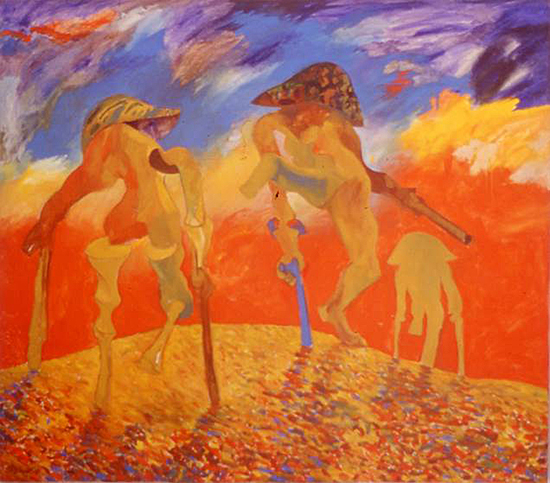
Even at the "Dance of Victory“ which illustrates the title of the picture, the figures do not appear as heroes but as vulnerable and pitiable. For his work the painter uses a very clear, simple and easily decodable visual language, staying loyal to his intensive colour palette of yellow and orange hues.
During an interview, Thenuwara comments on the intention behind his work:
C. T.: ... sometimes I have to do political work and [sometimes I need to work on] the human figure …
S. G.: You divide these two aspects, but do you also bring them together in a way?
C. T.: I’m trying now to bring them together. Sometimes you need modern art forms, sometimes you need the orthodox conventional art forms to deliver a message. I’m lucky I can do both. If I need a figurative expression I can do it. I have the skill and the training, [and that is] an advantage.
S. G.: You vary your technique so that the people can understand your works better?
C. T.: Yeah, yeah, and that’s why I might have to repeat the same thing again and again to simplify the work and do more political exhibitions than exhibitions only to show [my] capacity as an artist.
(Sabine Grosser (S. G.) interview with Chandraguptha Thenuwara (C. T.) 2.4.2002)
With the mentioned works both artists remained in the visual language of modernity as it was received in the local context: on one hand there were distinctly decodeable pictorial symbols to be identified, on the other hand pictorial subject matter was not depicted in a naturalistic sense, but rather realized with a certain degree of abstraction, by use of clear colours and an expressive flow. Many young artists adopted this working method for themselves during this period, predominantly painting picture panels with oil and acrylic that stylistically reflect the local debate on modernity: The paintings had distinct colours, were expressive in style with a mostly fragmented composition . At the same time they focused on the statement and the communicated message of the painting, which often combined the political and the personal level.
During the turn of the centuries more and more artists explored the subject of war and violence through their paintings and discussed the possibilities of art as a political instrument. With the already mentioned expressive visual language the artists met the taste of the majority of the local audience. The question of which artistic instruments would best accomplish the intended effects on the viewer, also increasingly became a theme of debate.[3] The artists now reflected on their role in society by discovering various possibilities of art and instrumentalizing cultural events as political forms of action. Jagath Weerasinghe’s exhibition "Anxiety of Today“ (1992) served as a framework to try out new forms of artistic expression. At the opening two artist friends, Nimal Mendis and Anna Paff (Cologne), staged the first performance in a Sri-Lankan art context: They demanded the right to a burial as a basic individual right. Their faces were painted white and they were dressed in white gowns during the performance, in which they carried black coffins into the hall, eventually destroying them.
In 1997 two installations at the Heritage Gallery in Colombo enriched the discussion: Chandraguptha Thenuwara‘s "Barrelism“ and Jagath Weerasinghe’s "Yantra Gala and the Round Pilgrimage“. Jagath Weerasinghe referred to his Buddhist background and combined artistic, political and spiritual aspects. Chandraguptha Thenuwara described himself most clearly as a political artist. Human and social aspects based on humanitarian ideals were the most important for him to highlight in this context, and with the work complex of the so called “Barrelism”, series of camouflage works launched in 1997, Thenuwara realized this high ambition most consequently. The ending “–ism” reminds us ironically of various “isms” in art history.
The first artwork in this series was an oil painting titled “Camouflage” (100 x 149,5 cm). Human figures holding crutches arise like silhouettes in between the camouflage patterns.
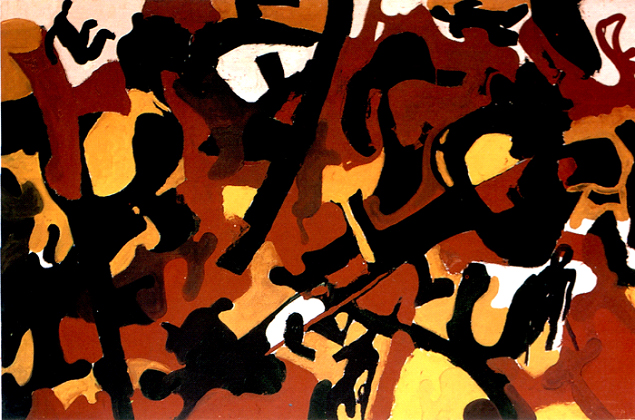
In order to address as many different people as possible Chandraguptha used various artistic styles and techniques to transmit his ideas. The most important thing for him was the intended political message.
Most consequently he used military barrels (employed in militarycheckpoints and elsewhere, interrupting public life in the capital Colombo) which he combined with his paintings, like in the installation ‘Woman in Barrelistic Area’, but he also used them for art installations in public space.
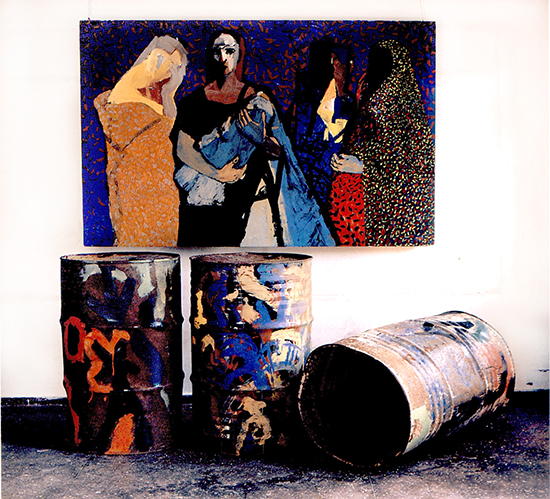
The exhibitions intensified the public discussion and more young artists raised their voice. Both formally and thematically they went beyond the limitations of easel painting and contributed to a public process of opinion making against the war.
Pradeep Chandrasiri, born 1968 and himself a victim of a torture camp, was one of the young artists who connected to the local visual context with his installation “Broken Hands”. Chandrasiri used a very common type of clay as material for the hands lying on wooden piles in different heights. In combination with charcoal, oil lamps and beetle leaves he evoked impressions of a local everyday culture beyond its representations in temples or museums.
The artworks of Sujith Rathnayake, born 1971 in Ranna, Sri Lanka referred to the aesthetics of the local print media of this time: The general representation of the war was dominated by pictures of scattered body parts of the suicide bombers depicted in the local press without restrictions.
Sujith Rathnayake implemented these pictures in his artwork and also combined them with his own gestural paintings. With the title “After the Town Hall Bomb”, he referred to an assault on Chandrika Kumaratunga Bandaranaike in front of the town hall in Sri Lanka’s capital Colombo. The young artist described very clearly how suddenly his daily life was affected by the presence of war:
In an instant, the “Town Hall Bomb” transformed that area into a war zone. Though I have never met or seen Chandrika in real life, the fact that a bomb was meant to kill her made that night extremely difficult to bear. The silent head of the suicide bomber suddenly reminded me of a girl I used to date some time back and war became a reality in the inner realms of my being.[4]
Tamil artists were not visible in the local art scene in Colombo during the nineties as the country was divided. Only in 2002 the Paradise Road Gallery showed a solo-exhibition by Thamotharampillai Shanaathanan. This prominent artist was born 1980 in Jaffna, studied art in India at the University of Delhi and currently works at the Art Department of Jaffna University. In his art work, in which one major topic is the interrelatedness of the individual with his surroundings, he combines Tamil traditions with postmodern thinking.
On the catalytic effects of war
The examination of war also had a congregational effect on the artists. Despite their different opinions, they united in order to take a public stand. They formed coalitions with other groups, at the same time as they reflected on their societal and public role. As it turned out, people accepted them in their increasingly public function, gradually turning them into the voice of a public opinion agitating for peace.
In this sense the war served as a catalyst for artistic development: new stylistic methods and forms of expression such as installations and performances were tested and implemented. The exhibition space was discovered and used as a sanctuary for political expression, combined with the increased use of public space as an arena of art, which stimulated the creation of opinions.
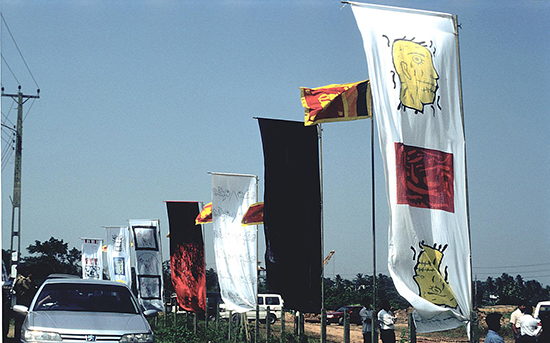
In parallel with this thematic and stylistic development and the mobilizing effect of war on the art community at large, the artists particularly worked on systems of distribution and display for their art. Mobile concepts played an increasingly important role, such as the concept for a mobile exhibition of flags "Artists Against War: Flag-Project-Workshop“ ("Noothana Sithuvam Vansaya“) designed by Sri Lankan artists and presented at various public places of political interest, like in 1999 at the opening of the peace memorial "Shrine of Innocents“ designed by Jagath Weerasinghe in Battaramula (Colombo).[5]
When Dr. Neelan Thiruchelvam, a lawyer, politician and human rights activist became a victim of a political assassination in 1999, the artists reacted promptly with a street art painting at the place of the assassination and were united – apart from varying artistic confrontations – in the Neelan Thiruchelvam Commemorative Programme - an Art Exhibition for Peace and Reconciliation (2000).[6]
The artists also associated with other groups in society, e.g. the Vibhavi Academy of Fine Arts which organized an exhibition in cooperation with the Centre for Ethnic Studies (ICES) and the Law & Society Trust & Thiruchelvam Association.
In addition to exhibitions, lectures and briefings, means of advertising were increasingly being used. In 2000, an association of industrialists launched a large-scale print and TV advertising campaign under the slogan "Sri Lanka First" with full-page newspaper advertisements and commercials for peace. An impressive climax to this campaign was a human chain from the airport to the southern tip of the island. At the time, public opinion was clearly against the war. Ranil Wickramasinghe was elected in December 2001, and in February 2002 the new prime minister agreed to an official ceasefire.
Even after the ceasefire the artists continued their work. In 2002 they ran the exhibition "ART PEACE" at the Lionel Wendt Gallery in Colombo and in 2003 artists from Colombo organized, together with colleagues from Jaffna, the first exhibition in a city that had been inaccessible for many Sri Lankans for a long time.
This positive development was interrupted in 2006 with the re-intensification of the war, but even today, after the military ended the war in 2009, it is not completed. Rather, many representatives of the current artist generation continue to work politically and engage, not only in dealing with the trauma of war.
Sabine Grosser is Professor of Aesthetic Learning at the University of Applied Science, Kiel, and author of Kunst und Erinnerungskultur Sri Lankas im Kontext kultureller Globalisierung – Eine multiperspektivische Betrachtung als Beitrag zum transkulturellen Dialog, Oberhausen 2010.
[1] A special thanks to Chandraguptha Thenuwara, for his permission to publish his photos. More artists and their art works contributing to this development, like Kingsley Gunatillake, Muhanned Cader, Anoli Perera, Tissa de Alwis and others are described in: Grosser, Sabine: Kunst und Erinnerungskultur Sri Lankas im Kontext kultureller Globalisierung – Eine multiperspektivische Betrachtung als Beitrag zum transkulturellen Dialog, Oberhausen 2010.
[2] The interview is published in English in: Grosser, Sabine: Kunst und Erinnerungskultur Sri Lankas im Kontext kultureller Globalisierung – Eine multiperspektivische Betrachtung als Beitrag zum transkulturellen Dialog, Oberhausen 2010, p. 503 – 514.
[3] Compare the chapter: Die Reaktionen der lokalen Kritik, in: Grosser 2010, p. 342 - 345.
[4] Quotation of the artist, www.theerta.com/Presentations/artists.htm (21.3.2004).
[5] Commemorative culture takes a special role in this development but can’t be mentioned here due to the length of the article. Chandraguptha Thenuwara as well as Jagath Weerasinghe are also acting as pioneers in this direction, regardless of their very different ways of expression (compare: Einflüsse zeitgenössischer Kunst auf aktuelle Entwicklungen lokaler Erinnerungskultur, in Grosser (2010), p. 349 – 378).
[6] An exhibition catalogue was published by Anoli Perera, Jagath Weerasinghe and Chandraguptha Thenuwara in 2000.
Literature
Grosser, Sabine: Kunst und Erinnerungskultur Sri Lankas im Kontext kultureller Globalisierung – Eine multiperspektivische Betrachtung als Beitrag zum transkulturellen Dialog, Oberhausen 2010.











